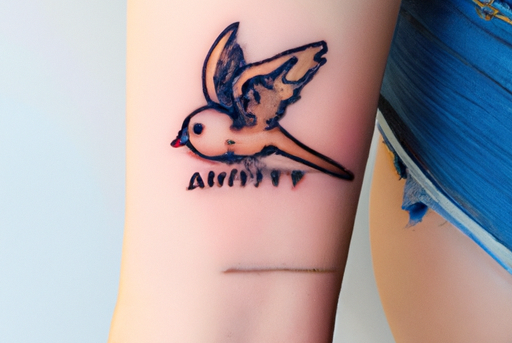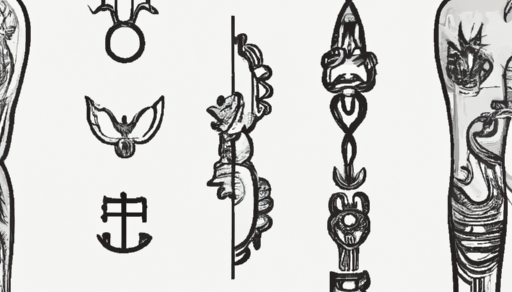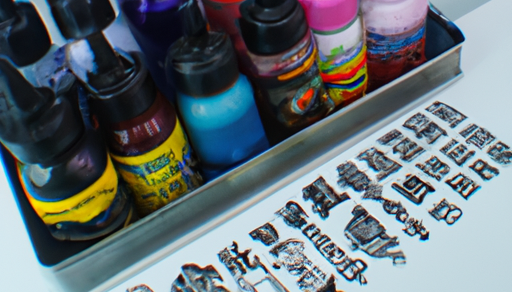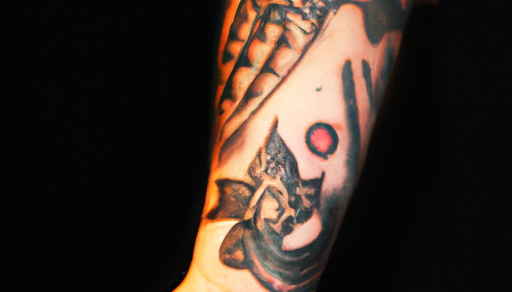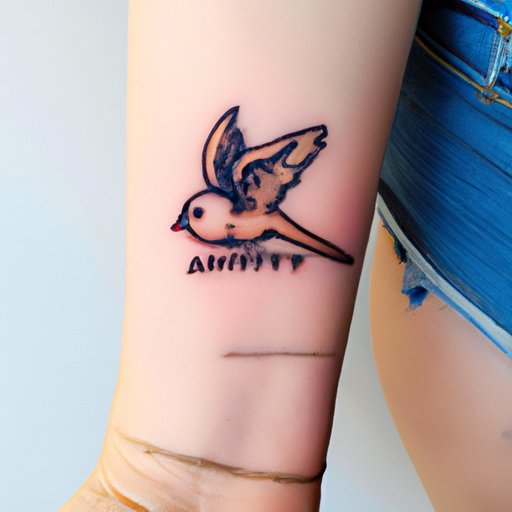Temporary tattoos have become increasingly popular in recent years as people have started to experiment with different types of body art without committing to a permanent tattoo. These tattoos offer a quick and easy way to express oneself through body art, without the long-term commitment or pain associated with a permanent tattoo. This blog post will provide you with everything you need to know about temporary tattoos,
Types of Temporary Tattoos:
There are several types of temporary tattoos available today, some of the popular ones are as follows:
 Temporary Tattoos: Transfer Tattoos
Temporary Tattoos: Transfer Tattoos
Transfer tattoos, also known as temporary tattoos, are a type of body art that can be applied to the skin using transfer paper. These tattoos are popular among people who want to experiment with body art without the commitment of a permanent tattoo.
Transfer tattoos are created by printing designs onto transfer paper using special inks. The design is then transferred onto the skin using water. The transfer paper is typically transparent, allowing the design to show through when it is applied to the skin.
Transfer tattoos are available in a wide range of designs and styles, from simple black and white designs to full-color images. They are also available in a variety of sizes, making it easy to find a tattoo that fits your style and preferences.
Applying a transfer tattoo is a simple process. The skin should be clean and dry before applying the tattoo. The tattoo design is then cut out and placed face down on the skin. A damp cloth or sponge is used to wet the back of the tattoo, which activates the adhesive and allows the design to transfer onto the skin.
Once the tattoo is in place, it should be left to dry completely before touching or covering. Transfer tattoos typically last for several days, but their lifespan can vary depending on factors such as skin type and the placement of the tattoo.
Removing a transfer tattoo is also a simple process. The tattoo can be removed by soaking the area in warm water and using soap to gently scrub away the design.
Transfer tattoos are a fun and creative way to experiment with body art, and they are a great option for people who want to try out a design before committing to a permanent tattoo. They are also a popular choice for special occasions such as parties or festivals.
 Temporary Tattoos: Henna Tattoos:
Temporary Tattoos: Henna Tattoos:
Henna tattoos, also known as Mehndi tattoos, are a type of temporary tattoo that is created using a paste made from the henna plant. These tattoos have been a part of traditional cultures in India, Pakistan, and the Middle East for centuries, and have become increasingly popular around the world in recent years.
Henna paste is made by grinding the leaves of the henna plant into a fine powder and mixing it with water, lemon juice, and essential oils. The paste is then applied to the skin using a cone or brush, creating intricate and detailed designs. The paste is left to dry, and then scraped off, leaving behind a stain that can last for several weeks.
Henna tattoos are available in a wide range of designs, from simple patterns and shapes to intricate, full-body designs. Traditional henna designs often feature floral motifs, paisleys, and geometric shapes, and can be customized to suit individual preferences.
One of the benefits of henna tattoos is that the paste is all-natural and non-toxic, making it safe for most people to use. However, some people may have an allergic reaction to the essential oils or other ingredients in the paste, so it is important to test the paste on a small area of skin before applying a full design.
Henna tattoos are also popular for special occasions such as weddings, festivals, and other celebrations. They are often used to decorate the hands and feet, but can also be applied to other parts of the body.
Caring for a henna tattoo is important to ensure that the stain lasts as long as possible. The tattoo should be allowed to dry completely before touching or covering. Avoiding water, lotions, and oils for the first 24 hours after application can also help the stain last longer. The stain will gradually fade over time as the skin exfoliates, but can be maintained with regular applications of oil or lotion.
Henna tattoos are a beautiful and natural way to experiment with body art. Whether you choose a traditional design or create your own, a henna tattoo can add a touch of elegance and beauty to any occasion.
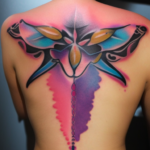 Temporary Tattoos: Airbrush Tattoos:
Temporary Tattoos: Airbrush Tattoos:
Airbrush tattoos are a type of temporary tattoo that is created using an airbrush gun and special, non-toxic inks. These tattoos are popular for events, parties, and festivals, and can be a great way to experiment with body art without the commitment of a permanent tattoo.
The process of creating an airbrush tattoo involves spraying the ink onto the skin through a stencil. The stencil is placed on the skin, and the artist uses the airbrush gun to spray the ink onto the skin in the shape of the stencil. The ink dries quickly, leaving behind a colorful and detailed design.
Airbrush tattoos are available in a wide range of designs and styles, from simple black and white designs to full-color images. They can be customized to suit individual preferences, and can be created in a variety of sizes.
One of the benefits of airbrush tattoos is that they are waterproof and long-lasting. With proper care, an airbrush tattoo can last for several days, making them a great option for events and special occasions.
Caring for an airbrush tattoo is important to ensure that it lasts as long as possible. The tattoo should be allowed to dry completely before touching or covering, and should be protected from water and other liquids. Avoiding excessive sweating or rubbing can also help to prolong the life of the tattoo.
Removing an airbrush tattoo is a simple process. The tattoo can be removed using soap and water, or with an oil-based makeup remover.
Airbrush tattoos are a fun and creative way to experiment with body art. Whether you choose a simple design or a full-color image, an airbrush tattoo can add a touch of excitement and personality to any occasion.
 Temporary Tattoos: Glitter Tattoos:
Temporary Tattoos: Glitter Tattoos:
Glitter tattoos are a type of temporary tattoo that adds sparkle and shine to the skin. These tattoos are created by applying a special adhesive to the skin and then sprinkling glitter over the adhesive. The result is a dazzling and eye-catching design that can last for several days.
The process of creating a glitter tattoo is simple. The skin should be clean and dry before applying the adhesive. The adhesive is then applied to the skin in the desired shape or design using a stencil or freehand drawing. Glitter is then sprinkled over the adhesive, creating a sparkling and shimmering effect.
Glitter tattoos are available in a wide range of designs and colors, from simple shapes and patterns to intricate, full-body designs. They can be customized to suit individual preferences, and can be created in a variety of sizes.
One of the benefits of glitter tattoos is that they are waterproof and long-lasting. With proper care, a glitter tattoo can last for several days, making them a great option for events and special occasions.
Caring for a glitter tattoo is important to ensure that it lasts as long as possible. The tattoo should be allowed to dry completely before touching or covering, and should be protected from water and other liquids. Avoiding excessive sweating or rubbing can also help to prolong the life of the tattoo.
Removing a glitter tattoo is a simple process. The tattoo can be removed using soap and water, or with an oil-based makeup remover.
Glitter tattoos are a fun and glamorous way to experiment with body art. Whether you choose a simple design or a full-body glitter extravaganza, a glitter tattoo can add a touch of sparkle and shine to any occasion.
Applying Temporary Tattoos:
Applying temporary tattoos can be a fun and easy way to experiment with body art. There are several types of temporary tattoos available, including transfer tattoos, henna tattoos, airbrush tattoos, and glitter tattoos. Each type of temporary tattoo has its own unique application process, but there are some general guidelines that apply to most types.
Tips for applying temporary tattoos:
Clean and dry the skin: The area where the tattoo will be applied should be clean and dry. Use soap and water to remove any dirt or oil from the skin, and pat it dry with a clean towel.
Cut out the tattoo: If you are using a transfer tattoo, cut out the design from the sheet of paper. Make sure to leave some extra space around the design.
Remove the backing: Peel off the backing paper from the transfer tattoo, or remove the stencil if you are using an airbrush tattoo or a henna tattoo.
Apply the tattoo: Place the tattoo face down on the skin, making sure that it is in the desired position. Press down firmly on the tattoo with a damp cloth or sponge, and hold it in place for 30-60 seconds.
Remove the paper: Carefully peel off the paper backing from the transfer tattoo, or remove the stencil if you are using an airbrush tattoo or a henna tattoo.
Allow the tattoo to dry: Let the tattoo dry completely before touching or covering it. This will help to ensure that the design stays intact.
Care for the tattoo: Depending on the type of temporary tattoo, there may be specific care instructions to follow. Generally, you should avoid rubbing or scratching the tattoo, and protect it from water and other liquids.
Removing temporary tattoos is usually easy and straightforward. Most can be removed with soap and water, or with an oil-based makeup remover.
Caring for Temporary Tattoos: 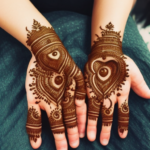
Caring for temporary tattoos is important to ensure that they last as long as possible and look their best. There are several types of temporary tattoos available, including transfer tattoos, henna tattoos, airbrush tattoos, and glitter tattoos. Each type of temporary tattoo has its own unique care requirements, but there are some general guidelines that apply to most types.
Tips for caring for temporary tattoos:
Keep the tattoo dry: Most temporary tattoos are waterproof, but excessive exposure to water can cause them to peel or fade. Avoid soaking the tattoo in water, and pat it dry with a towel after bathing or swimming.
Avoid rubbing or scratching the tattoo: Rubbing or scratching the tattoo can cause it to peel or fade. Be gentle when washing the area around the tattoo, and avoid using harsh soaps or exfoliants.
Protect the tattoo from sunlight: Sun exposure can cause temporary tattoos to fade or discolor. If you plan to spend time outdoors, cover the tattoo with clothing or sunscreen.
Avoid oils and lotions: Oil-based products, such as lotions and sunscreen, can cause temporary tattoos to dissolve or smudge. Avoid applying these products directly to the tattooed area.
Remove the tattoo gently: When you are ready to remove the tattoo, do so gently. Use soap and water, or an oil-based makeup remover, and rub gently until the tattoo is gone.
Store the tattoo properly: If you have unused temporary tattoos, store them in a cool, dry place away from direct sunlight. This will help to preserve their quality and prevent them from drying out.
